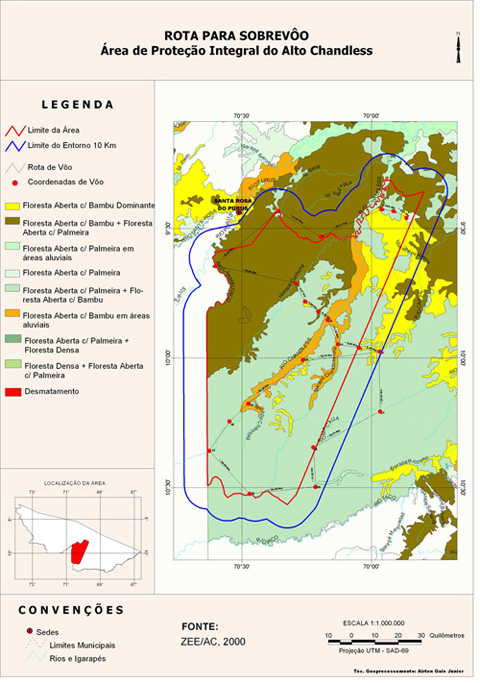Languages
PE Chandless (State Park)

The Chandless State Park is an Integral Protection Conservation Unit, created by Decree 10.670, in September 2, 2004. It has an area of 670,135 hectares, representing 4.23% of the territory of Acre and covers the municipalities of Santa Rosa do Purus (161,630 Ha - 24.12%), Manoel Urbano (445,208 ha - 66,44%) and Sena Madureira (63,296 ha - 9.45%). Its boundaries start at the Brazil / Peru border, located near the source of the Santa Rosa River, the Municipalities of Feijó and Manoel Urbano. Access to the area is considered to be extremely difficult and starts over land leaving Rio Branco and going to Manuel Urbano and from there to the UC headquarters by river. It is also possible to access the area by air charter, leaving Rio Branco and landing at the Unit. The vegetation is considered to be inhospitable due to the forests having a high concentration of thorny bamboo.
The area is totally situated within the limits of the green corridor of the Western Amazon, one of five for the Amazon region which were established by IBAMA. It is also adjacent to protected areas and Indigenous Lands on the Peruvian side, where rare and endemic species have recently been identified. It is also a local corridor, connecting two indigenous areas (Purus and Mamoadate rivers) and the Acre River Ecological Station.
The Park is located in one of the least known regions of the state in terms of biological richness, the Upper Purus region, in the Purus and Chandless river basins. This region is considered the center of distribution of the tabocais of the southwest of the Amazon, where they occur forests dominated by arborescent bamboos of the genus Guadua. Its boundaries are: to the north the Alto Rio Purus Indigenous Land; south the Mamoadate Indigenous Land; west the Republic of Peru with direct limits with the UC's Alto Purus National Park and Purus Communal Reserve and to the east, the Cazumbá-Iracema Extractive Reserve. It comprises two important ecological corridors, which covers the Brazilian lands called the Southwest Amazon Corridor and the Peruvian Corridor called the Vilcabamba-Amboró Conservation Corridor.
The objective of the Unit is "to ensure the preservation of natural ecosystems of great ecological relevance, enabling the carrying out of scientific research and the development of activities of education and environmental interpretation, recreation in contact with nature and ecological tourism."
According to Chandless PE, there are at least 800 bird species (including migratory species), at least 200 species of mammals, 80 species of reptiles and 120 species of amphibians. About 100 species of lepidoptera were identified. The ichthyofauna around 200 species. The work carried out to elaborate the Plan of Management of the Unit through the Rapid Ecological Assessment - AER registered more than a thousand species for the area, being 264 species of plants, among which 24 of palms, 47 species of large mammals, 63 species of amphibians , 40 species of reptiles, 407 species of birds, among these 13 are exclusive to the taboca formations, 464 species of lepidoptera and 71 species of fish. The plan was completed in 2010 and indicated a series of priority research for the UC, which can assist the management of the same.
Description
The mean annual precipitation of the Alto Chandless region varies from 1773 mm to 2086 mm and the average annual temperature ranges from 24.3oC to 25.1o C. The soil types are plinthosol, argisol, vertisol, luvisol, neosol, with predominance of cambisol and has a smooth and wavy relief. The rivers are white water with a significant dynamic of flood and ebb. The period of flood occurs between the months of October to May and the period of drought between the months of June to September. Vegetation is characterized by open forests of palm trees and open bamboo forest.

Research History
The research carried out in the conservation unit was for the creation of the area in 2004 and to prepare management plan, that occurred in 2008. The method used was the Rapid Ecological Assessment. The plan was completed in 2010 and indicated a series of priority research for the UC, which can assist the management of the same.
Metadata
Guidelines to facilitate the search in the repository: in the search page of the link above type the keyword: Chandless
Funding Providers
Programa Áreas Protegidas da Amazônia - ARPA
Programa de Desenvolvimento Sustentável do Acre - BID - Acre

For a better resolution map, click here.
More information
See also the maps:
In 2010, TV Aldeia reported on the Field Ecology Discipline carried out by NR Acre, the Graduate Program in Ecology and Natural Resource Management of the Federal University of Acre (MECO) and the State Department of Environment (SEMA) in the PE module of Chandless. Watch it here !.
Contact
Marcos Silveira
Centro de Ciências Biológicas e da Natureza
Laboratório de Botância e Ecologia Vegetal
Universidade Federal do Acre
BR 364, Km 04 - 69915-559
Rio Branco-AC
Telefone: +55 68 3901-3582 – Fax: +55 68 3229-1246 Celular: +55 68 99739747

